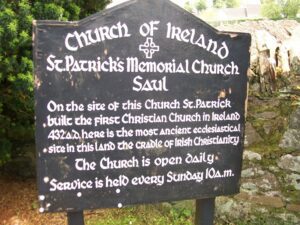The Man Behind The Holiday
By Michelle Allan
 Ah, spring. There are many holidays a-comin’, we had those in winters gone by, and more to praise God for when the first robin sings. Now that St. Valentine’s Day has passed, we prepare expectantly for Larry Leprechaun, green, green grass, and maybe even some four leaf clovers or a pot of gold.
Ah, spring. There are many holidays a-comin’, we had those in winters gone by, and more to praise God for when the first robin sings. Now that St. Valentine’s Day has passed, we prepare expectantly for Larry Leprechaun, green, green grass, and maybe even some four leaf clovers or a pot of gold.
But what if someone were to mention the man behind the holiday, St. Patrick? “Huh? Who is he?” would probably be the response of the majority of this country. Well, here we go. Get ready for an exciting adventure into Ancient Ireland, the birthplace of this incredible man, and an amazing journey into a godly life such as this.
It is unknown when St. Patrick was born, but many historians believe that he came into the world in the early 5th century.
“He was born somewhere along the west coast of Britain in the little settlement or village of Bannavem of Taburnia (vico banavem taburniae in his Confession), which has never been securely identified. Sites suggested include Dumbarton and Somerset, or the coastline of Wales or northern France; another possibility put forward for his birthplace is the settlement of Bannaventa in Northamptonshire), for pagan raiders captured him with ‘many thousands of people’ and sold them as slaves in Ireland.”
This was due to the fact that Patrick was raised in a Christian home by his father and mother, a deacon, and his mother was believed to be of the Martin of Tours family, an “upper-class” family in Gaul (modern-day France.). “Although he came from a Christian family, he was not particularly religious before his capture.” It was only after the capture that Patrick would grow incredibly in his faith, even for being captured at 16, and his father’s death after he escaped at the tender age of 22. Wow! What a terrible time that must have been!
Soon, Patrick would go on to do more than just growing his faith. He would become one of the most influential men in the entire Christian world, as well as earning recognition from people of other faiths ( I can easily see why…).
Patrick became a missionary in Ireland in 432 or 462 AD. He became much like those before him, such as Palladius and Secundus. He worked in many places, and even helped to convert people in the cities of Ulster and Connaught, which had not had any exposure to God before to Patrick came to these places.
Having been under Roman rule for about 350 years before, most of Britian was now pagan due to the influence of those known as Anglo-Saxons and even the Roman rulers, who had left Ireland in 407 and 410 AD. However, Patrick was about to change all that.
 The first man who was converted under Patrick was Dichu, who is most noted for building a sabhall (barn) for Patrick to be used as a “church sanctuary.” This was the first of many dedicated by Patrick, and he would often retreat there in later years. He would even die in this particular sanctuary, and by his death on March 17, 491(AD), a monastery and another church had been erected. That particular place, Saul County Down, is still known as Sabhall (pronounced Saul).
The first man who was converted under Patrick was Dichu, who is most noted for building a sabhall (barn) for Patrick to be used as a “church sanctuary.” This was the first of many dedicated by Patrick, and he would often retreat there in later years. He would even die in this particular sanctuary, and by his death on March 17, 491(AD), a monastery and another church had been erected. That particular place, Saul County Down, is still known as Sabhall (pronounced Saul).
Wow. Is that an incredible story or what? That just proves how far faith can carry someone, and would sureprove God’s existence to me. Leprechauns? What leprechauns? I ain’t seen no leprechauns …… Hmmm ….. Curiouser and curiouser, eh?
So , when we prepare for St. Patrick’s Day, let’s think about how much God can really work, even in something so complicated as the life of St. Patrick. Are you ready to fight for your faith, and do whatever it takes to help like Patrick did? I am. So, let’s get out and there and follow St. Patrick’s example! Good luck.
By the way…
Did You Know
- The story of the annual vernal fire that was to be lit by the High King at Tara, when all the fires were extinguished, to be renewed from the sacred fire from Tara, and of Patrick’s rival, miraculously inextinguishable Christian bonfire on the hill of Slane at the opposite end of the valley, is famous among his many exploits. The season was associated with Easter (compare the British season of Eostre) by the Christian chroniclers who followed Patrick’s own account in his Confession.
- Mythology credits him with banishing snakes from the island, though others suggest that for climatic reasons post-glacial Ireland never actually had snakes; one suggestion is that snakes referred to the serpent symbolism of the Druids of that time and place, as shown for instance on coins minted in Gaul (see Carnutes), or that it could have referred to heretical beliefs such as Pelagianism, symbolized as “serpents.”
- Legend also credits Patrick with teaching the Irish about the concept of the Trinity by showing people the shamrock, a three-leaved clover, using it to highlight the Christian dogma of ‘three divine persons in the one god’ (as opposed to the Arian heresy that was popular in Patrick’s time). Though it should be noted that tripartine gods were not new to the Irish pagans.
Interesting, eh? So, let’s get out and be like Jesus to the people around us, as St. Patrick was. May God Bless you on your journey. Who knows what could happen? Just put your trust in God, and you will be amazed.





Be the first to comment